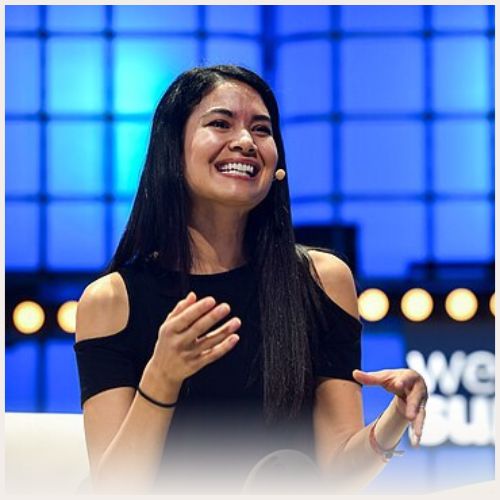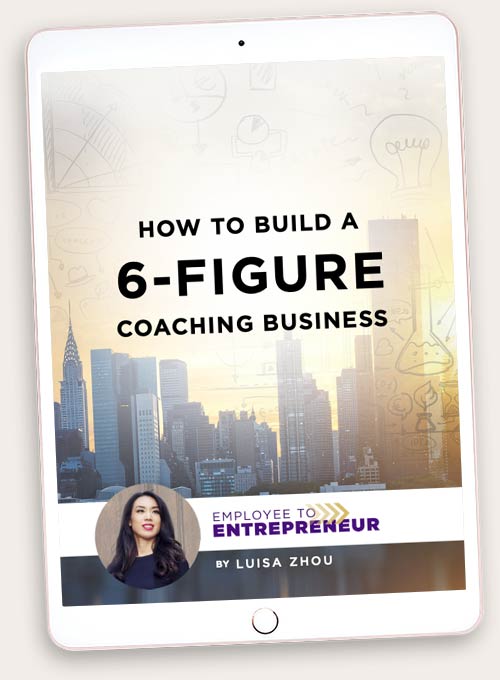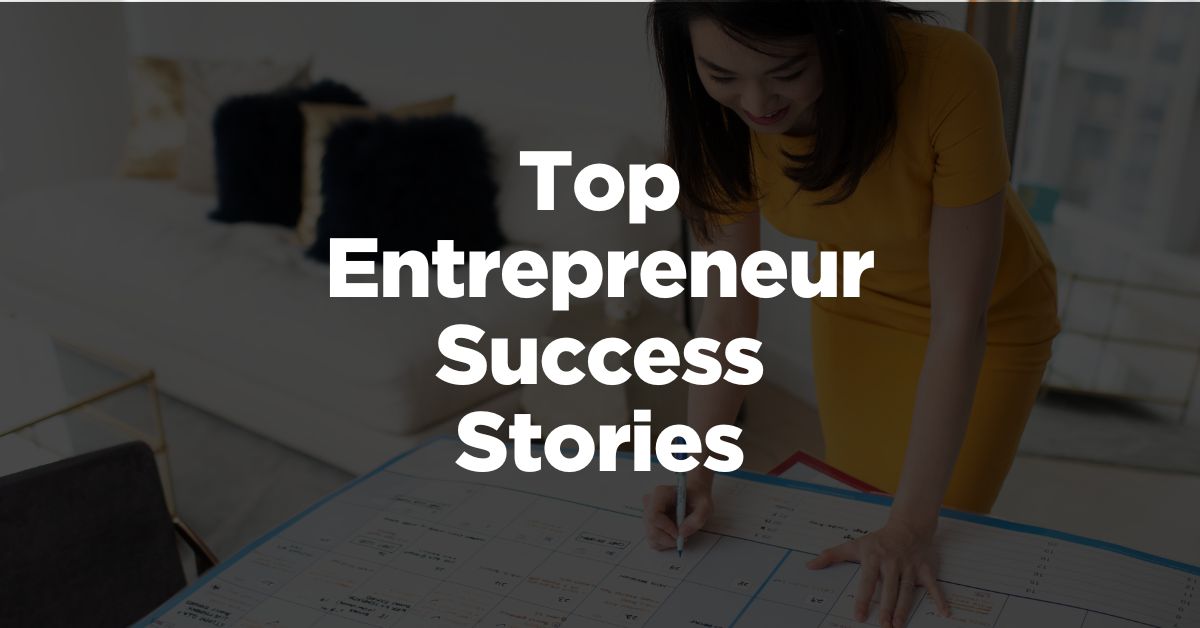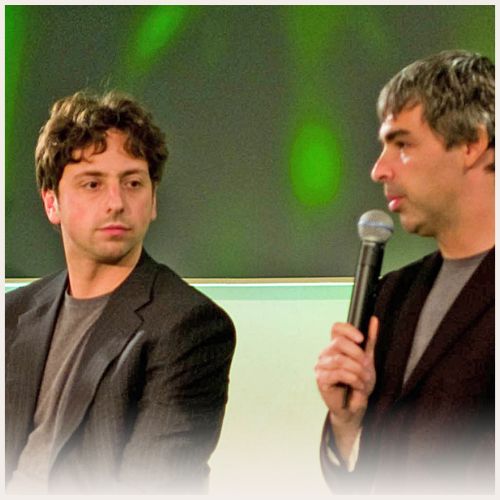Can YOU start a successful business?
One of the best ways to learn how to build a business is to look at others who are where you want to be.
And today, we’ll look at inspiring entrepreneur success stories to help you grow. Read on!
10 inspirational entrepreneur success stories
How many entrepreneurs actually succeed?
50% of businesses fail within the first 5 years. But those who DO succeed are people who built businesses people love and share characteristics like grit and creativity.
Here are ten entrepreneur success stories to help you think bigger.
Melanie Perkins, Cliff Obrecht, and Cameron Adams, Canva

While studying at the University of Western Australia, Melanie and her boyfriend Cliff saw their classmates struggling with graphic design software. They realized the need for a more accessible tool.
The goal was “to take the entire design ecosystem, integrate it into one page, and then make it accessible to the whole world.”
Get the Ultimate Guide
for building a
6-Figure Coaching Business so you can achieve more freedom!
They first launched Fusion Books, a yearbook creation platform, in 2007. It was a success (and still operates today), but the bigger picture was to launch an all-encompassing design site.
So Canva was born.
They began pitching to Silicon Valley investors in 2010 but got rejected 100 times before meeting Bill Tai, who connected them to interested investors.
In 2012, they met their tech co-founder, Cameron Adams.
Canva officially launched in 2013 to a waiting list of more than 50,000 people. Its drag-and-drop interface, template library, and freemium model made it an immediate hit.
By the end of its second year, it had more than 100,000 users and 1.8 million designs.
Today, it has 135 million users and has been named one of TIME’s most influential companies.
Canva became a startup “unicorn” – a startup valued at $1 billion – in 2018. It currently has a valuation of $40 billion.
As of 2023, it has an annual revenue of $1.7 billion.
Whitney Wolfe Herd, Bumble
Whitney Wolfe Herd, founder of Bumble, got her start as co-founder of Tinder. She left Tinder shortly after, in 2014, due to alleged sexual harassment.
She set out to make her own dating app, Bumble. Her goal was to do away with old-fashioned gender dynamics and make dating safer for women by allowing them to initiate the conversation.
At first, the idea was rejected because investors were hesitant about an app that defied social norms.
But Andrey Andreev invested $10 million, and the app launched in December 2014.
Within the first year, the app had 1 million users. Herd expanded Bumble to include options for friendship (BFF), networking (Bizz), and even international matches (Travel).
The company has gone on to acquire Badoo, Fruitz, and Official.
Today, Bumble Inc. operates in 150 countries and has over 50 million users – over 3 million of which pay for subscription-based models.
The company went public in 2021 with a valuation of $8.6 billion, making Whitney the youngest self-made billionaire in the world.
In Q3 of 2023, Bumble Inc.’s total revenue grew to $276 million, while the app’s revenue grew to $222 million.
Brian Chesky, Nathan Blecharczyk, and Joe Gebbia, Airbnb

In 2007, a design conference was being hosted in San Francisco – and several attendees couldn’t find a hotel room.
So two roommates, Brian and Nathan, decided to inflate a few air mattresses in their apartment and rent them out for $80 per night.
They called it Air Bed and Breakfast.
Realizing its potential, they reached out to their former roommate, Joe, to turn it into a business.
In 2008, they met with investors for the first time. Seven of the 15 investors they met with ignored them, and eight said no.
They didn’t want to give up but needed more funding. Ahead of the 2008 Democratic National Convention, they started making presidential-themed cereals (Obama O’s and Cap’n McCains) and made $30,000.
In 2009, they shortened the name to Airbnb and secured a $600,000 investment to continue growing it.
And by 2011, it operated in 89 countries, had 1 million stays booked, and won SXSW’s break-out mobile app award. Airbnb also received $112 million in funding, reaching a valuation of more than $1 billion – it was a “unicorn.”
Today, the app has changed how we travel and has grown to over 7 million listings in 220 countries. It now goes beyond private rooms to offer entire homes and even experiences.
In 2023, active listings grew by 19%, and revenue increased to $9.6 billion.
Oprah Winfrey
Oprah has been a household name since the 80s, making hers one of the most popular entrepreneur success stories to tell.
Despite having an unstable childhood and growing up in poverty, Oprah became Miss Black Tennessee at 17. She was then given an on-air job at a Nashville radio station before getting a full scholarship to Tennessee State University.
After college, Oprah became an evening news reporter in Baltimore – but was fired for getting too emotionally invested in her stories.
Regardless, she didn’t give up.
In 1986, she became the first Black woman to host a nationally syndicated talk show (The Oprah Winfrey Show) in 1986. The show lasted 29 seasons and had 15 million viewers per day.
At one point, she was the highest-paid entertainer on television.
Though the show went off the air in 2011, Oprah is still on the move.
She became the founder of Harpo Productions, CEO of the Oprah Winfrey Network, and co-founder of Oxygen Media. She also owns an equity stake in Weight Watchers.
Oprah remains heavily involved in her ventures and also focuses on philanthropy. She has founded Oprah’s Angel Network, the Oprah Winfrey Charitable Foundation, and was a founding donor of the National Museum of African American History and Culture.
She has a net worth of $2.8 billion.
Larry Page and Sergey Brin, Google
Larry and Sergey met as Ph.D. students at Stanford University in 1995.
Both were getting degrees in computer science and wanted to find a better way to organize the information on the internet and make it accessible to everyone.
So, in their dorm rooms, they built a search engine that relied on links to rank and organize individual pages. They called it Backrub, but it would eventually be renamed Google.
In 1998, they received an investment of $100,000, and Google, Inc. was moved from dorm rooms to the garage of Susan Wojcicki (who would go on to be CEO of YouTube).
They toyed with selling the project to internet company Excite for $1 million the following year but couldn’t get the deal through, even when they lowered the price to $750,000.
So they held onto the company, even when Yahoo offered to buy it for $3 million in 2002.
Get the Ultimate Guide
for building a
6-Figure Coaching Business so you can achieve more freedom!
They made the right choice. Google stood out because it only offered the most relevant search results and had a minimalist design.
When it went public in 2004, the company had a valuation of $27 billion.
Google continued to grow, expanding to include Adwords, Gmail, Google Maps, Google Earth, and Chrome. It even acquired assets like the Android operating system and YouTube.
Today, “googling” remains synonymous with online search.
The company was restructured as Alphabet in 2015, which elevated Larry and Sergey from day-to-day operations to CEO and president of Google’s holding company. Larry was CEO from 2001 to 2011, and Sergey was President until 2019.
The company saw a 5% increase in revenue in 2023, totaling $297 billion.
Jan Koum, WhatsApp
Jan Koum, founder of WhatsApp, is the epitome of entrepreneur success stories.
His family immigrated to California from Kyiv when Jan was 16 and relied on food stamps to get by.
His fascination with computers inspired Jan to learn computer programming. He got a job at Yahoo, where he worked while attending San Jose State University.
He stayed at Yahoo for almost ten years and met his future business partner, Brian Acton, there.
In 2009, Jan got frustrated with the number of calls he was missing on his new smartphone and wanted to create a platform that would make it easier for friends and family to know if he was available.
That was the only aim of the app he and Brian built, but they managed to democratize communication.
WhatsApp – a shortened form of “What’s up?” – offered a simple, reliable messaging app that challenged the costs and difficulties of the traditional SMS system. It also protected users with encryption and refused to allow companies to advertise on the platform.
Despite landing a spot in Apple’s app store, user numbers were low.
But within five years, it became one of the most popular forms of communication in the world. At this point, the app had 400 million users globally, especially in areas where messaging costs were high.
Meta bought the platform for $19 billion in 2014, making Jan and Brian billionaires. Today, it’s one of the largest messaging platforms in the world, with over 1 billion monthly users.
Jan and Brian both left Meta by 2018 due to disagreements with the company about privacy concerns.
While Meta won’t reveal the size of WhatsApp, experts estimate that revenue is likely between $500 million and $1 billion per year.
Jeff Bezos, Amazon
Before founding Amazon, Jeff Bezos worked as a hedge fund manager in New York.
Recognizing the potential of the World Wide Web, Jeff left his job in 1994 to build a virtual bookstore in his garage. (Something his boss advised against.)
He called it Amazon, after the Amazon River, because he wanted his company to be the largest in the world.
After Jeff sold his first book in 1995, he never looked back despite challenges in raising funds. Of the 60 people he approached, nearly 40 said no.
But the remaining crowd each invested around $50,000 a piece into the venture.
Despite the dot-com bubble bursting in the early 2000s, and Amazon not earning a profit until 2 003, Jeff’s work paid off.
The company continued to grow. And instead of being just an online bookstore, it’s now a one-stop shop for almost everything.
Today, Jeff has expanded the company’s offerings to include Kindles, Amazon Web Services, Alexa, Prime Video, and more. The company even acquired Whole Foods Market and is pioneering palm payment technology with Amazon One.
But even more impressively, Amazon has set new standards for efficiency and logistics with the introduction of Amazon Prime and a two-day delivery guarantee.
Amazon went public in 1997 with an initial valuation of $300,000. Today, it’s worth more than $1.5 trillion and has a yearly revenue of $554 billion.
Jeff stepped down as CEO of Amazon in 2021.
Jack Ma, Alibaba
Jack Ma is one of the wealthiest people in China – but it took some time to get there. And his story isn’t a stereotypical one – Jack Ma failed his entrance exam to Hangzhou Teachers College twice.
After graduation, he worked as an English teacher at the Hangzhou Institute of Electronics and Engineering, where he earned $12 per month.
But when he traveled to the US in 1995, he encountered the Internet for the first time. It made him realize there was a lack of Chinese websites – and he saw a business opportunity.
When he returned to China, he founded China Pages, one of the country’s first Internet companies. It operated as a directory of Chinese companies for foreign customers but failed soon after.
Finally, he founded Alibaba Group in 1999 in his apartment. The idea was that Alibaba would function as an online marketplace that allowed exporters to offer products that foreign customers could buy directly.
It caught on, earning $25 million in investments in just a few months. In 2005, Yahoo invested another $1 billion.
Under Jack’s leadership, Alibaba’s portfolio expanded to include Taobao, an eBay competitor, Alipay, and AliExpress. It has also expanded into different sectors, including cloud computing (Alibaba Cloud), entertainment (Alibaba Pictures), finance (Ant Group), communications (DingTalk), and more.
When the company went public in 2014, it had the largest IPO in US history, raising $25 billion.
Today, the company is the largest e-commerce platform in China, with a revenue of more than $126 billion in 2023.
Jack stepped down as CEO in 2013 but remained executive chairman until 2020. After a regulatory crackdown on the Chinese tech sector, Jack now teaches English in Japan.
Sara Blakely, Spanx
Sara Blakely has one of the ultimate entrepreneur success stories.
She was selling fax machines door-to-door in Florida when she realized the need for an undergarment that eliminated visible panty lines, made her look thinner, and could be worn with open-toed shoes.
So she cut the feet off a pair of pantyhose and wore them under her pants – and knew she was onto something.
In 2000, he founded the shapewear brand Spanx with $5,000 of her own money in her apartment.
While she continued to work her day job, she spent her nights testing designs, developing prototypes, and searching for a factory that would bring her vision to life. She even filed for patents and created trademark designs on her own.
With her product in hand, she pitched her idea to department stores across the country before setting up shop in Neiman Marcus, where she sold Spanx at a table with her own pictures as marketing materials.
She caught a break in late 2000 when Oprah added Spanx to her product lineup, and sales skyrocketed. Another break came in 2004 when she competed on Richard Branson’s Rebel Billionaire.
Get the Ultimate Guide
for building a
6-Figure Coaching Business so you can achieve more freedom!
By 2010, Spanx was one of the best-known brands in the country. Since its inception, it has grown to include clothing, intimates, swimwear, and leisurewear, and is sold in more than 50 countries.
In 2012, the success of Spanx made Sara the world’s youngest self-made female billionaire at the age of 41.
In 2021, Sara sold a majority stake to Blackstone in a deal that placed Spanx’s valuation at $1.2 billion and saw Sara become executive chair.
It’s estimated that Spanx earns $400 million in revenue each year.
Luisa Zhou, LuisaZhou.com

I’m including myself here to show you that not all entrepreneur success stories have a rags-to-riches arc – and mine is one of them.
The truth is, I never wanted to become an entrepreneur. I’m introverted, didn’t want to start a business, and didn’t know any entrepreneurs growing up.
I didn’t even have an idea.
So I focused on what my immigrant parents taught me – my successful career.
But then I had several family members with health emergencies, and I didn’t have the flexibility to be there for them.
I knew I had to make a change, and started offering digital advertising consulting on the side.
That business started to grow. I was able to replace the income from my job, and then quit.
In a year, I made seven figures.
And today, my business is an eight-figure business.
What’s more, it’s a business that feels incredibly fulfilling to me and, as I’m mostly supported by my team, I can flexibly work a few hours a week on my business.
Entrepreneur success stories don’t always start with a million-dollar idea. You just have to find a way to use the skills you already have.
I did it, and so can you. I’ll talk about how in this guide.
What’s next?
There you have it! 10 inspiring entrepreneur success stories.
You can become an entrepreneur, too – and launching an online business is a great way to start because you don’t need a lot of funding.
I’ve helped thousands of people start their own businesses. And there are a few things those who go on to build successful, six, multiple six, or seven figure businesses have in common.
I’ll show you exactly what they are in this free blueprint:

Want to Build a 6-Figure Coaching Business So You Can Achieve More Freedom?
When you sign up, you’ll also receive regular updates on building a successful online business.
Read more:
The Top Characteristics of Successful Entrepreneurs
How to Think Like an Entrepreneur
Top Habits of Successful Entrepreneurs















